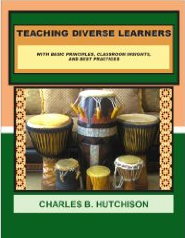March 2010 – Volume 14, Number 4
Teaching Diverse Learners: Basic Principles, Classroom Insights, and Best Practices
|
|||
| Author: | Charles B. Hutchison (2010) |  |
|
| Publisher: | Charlotte, NC: Catawba | ||
| Pages | ISBN | Price | |
|---|---|---|---|
| Pp. 2-251 | 978-1-59712-402-7 | $45-50 U.S. | |
In Teaching Diverse Learners: Basic Principles, Classroom Insights, and Best Practices, Charles B. Hutchison draws from his educational and cultural experiences to examine the challenges of teaching diverse learners. The author combines narratives of teachers’ and students’ learning experiences with statistical data in his examination of how educational and social issues, such as poverty, school drop-outs, and incarceration, among others, affect students and the nation as a whole. The author offers a broad range of knowledge that will help educators, parents, and students have a better understanding about issues that exist within many diverse schools and enhanced perspectives on teaching culturally and ethnically diverse students in diverse environments.
Teaching Diverse Learners begins with an argument of why society needs to embrace diversity in schools, especially schools in urban communities. In addition to issues residing within schools, students bring with them many social issues that may affect their academic achievement. The author presents issues students have in and out of school; however, he also offers strategies teachers, parents, and communities can implement to increase the success of students. Within each chapter, Hutchison presents various types of diversity that are not always acknowledged as much as they should be within school systems. For instance, gender, student sexuality, and religion are among the many issues that are sometimes not addressed when evaluating and developing a student’s education.
In its totality, Teaching Diverse Learners argues that teachers need to understand their students to teach effectively and to create an atmosphere that encourages achievement. Such a welcoming environment will encourage students to engage in classroom activities and truly value their education. Students will understand that teachers are there to help them inside and outside the classroom. When teachers develop a rapport with their students, these relationships create opportunities for students to revision the connection between education and being their own success as individuals. Or as Hutchinson argues, “Teachers, like Freire, can create conscious students who, because they have become more aware of social issues and how they relate to their own economic plight, may take their schooling more seriously, as a personal revolution” (p. 127). Having a better awareness of their students helps teachers find ways to encourage and motivate their children. Thus, even though the author describes many of the challenges that student face, he also includes strategies schools use to accommodate students in order to foster their learning.
Another topic the author focuses on is how teachers’ beliefs and teachers’ cultures affect their teaching methods within the classroom with the idea being that teachers need to reflect on “the unconscious assumptions they bring to the classroom” (p. 250). There are a number of noteworthy strengths in the book of particular value to parents, students, and teachers.
Teaching Diverse Learners is a great reading that I highly recommend to others. The strategies in this book could be complimentary to educators, enabling them to gain an insight towards success in the classroom for diverse learners.
Reviewed by
Sarah Johnson
The University of North Carolina at Charlotte
<sjohn276![]() uncc.edu>
uncc.edu>
|
© Copyright rests with authors. Please cite TESL-EJ appropriately.
Editor’s Note: The HTML version contains no page numbers. Please use the PDF version of this article for citations. |

